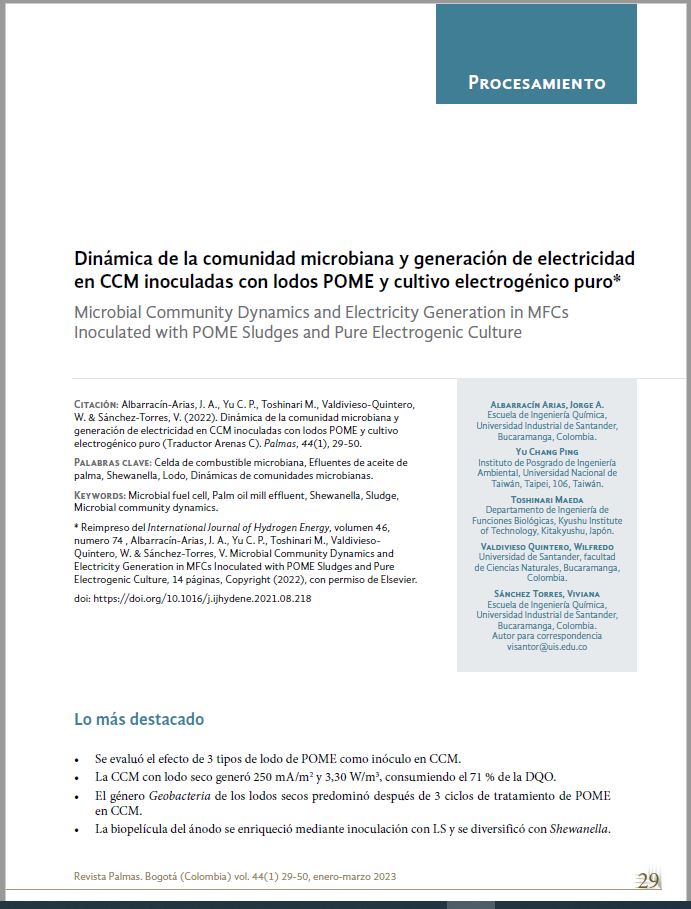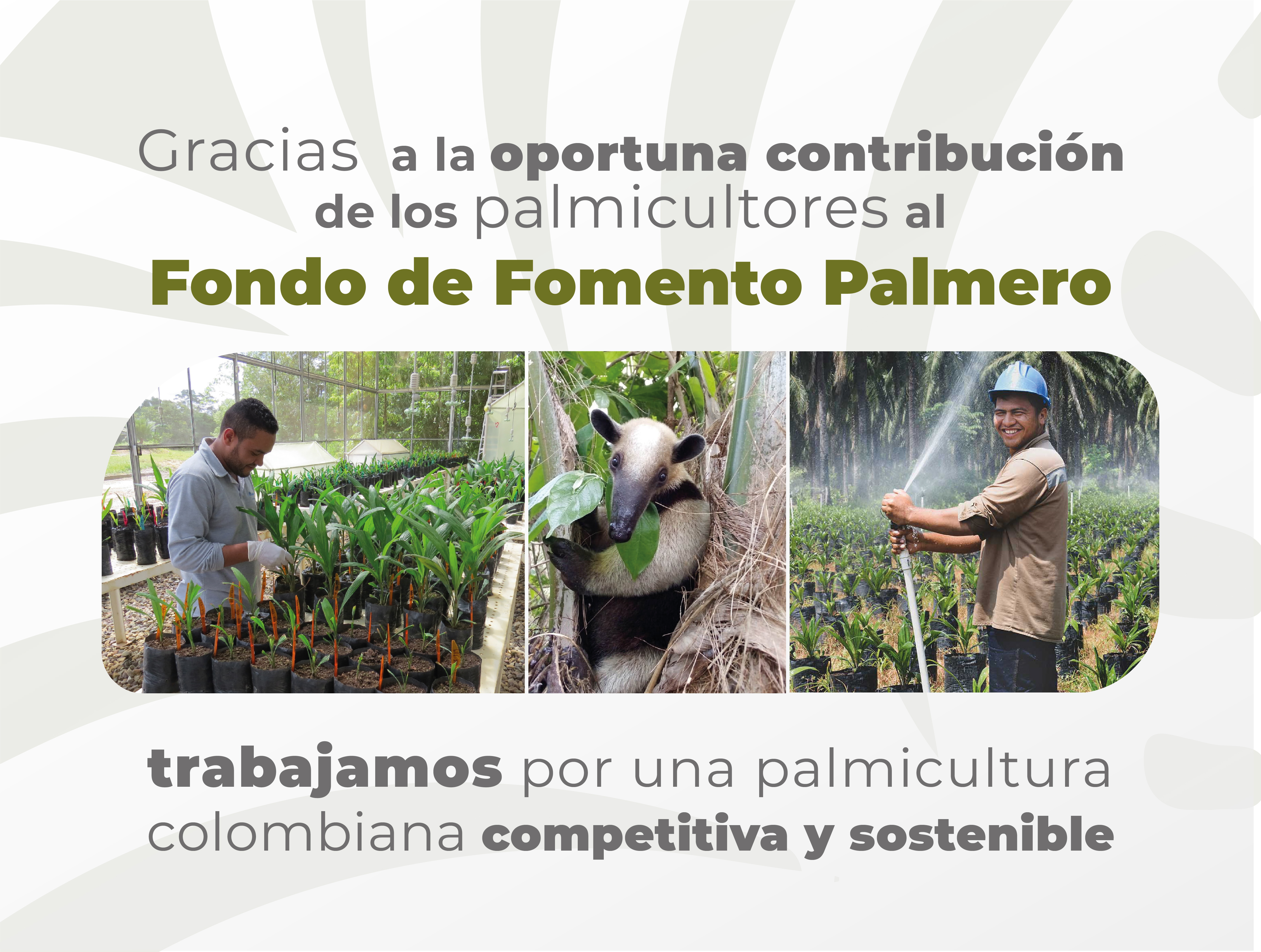Dinámica de la comunidad microbiana y generación de electricidad en CCM inoculadas con lodos POME y cultivo electrogénico puro
Palabras clave:
Celda de combustible microbiana, Efluentes de aceite de palma, Shewanella, Lodo, Dinámicas de comunidades microbianasResumen
Los efluentes del proceso de extracción del aceite de palma (POME por sus siglas en inglés) deben ser tratados antes de su disposición debido a su alto contenido de materia orgánica. En este estudio se evaluó el desempeño eléctrico y la eficiencia del tratamiento de aguas residuales mediante el uso de celdas de combustible microbianas (CCM) para el tratamiento de POME no estéril con una demanda química de oxígeno (DQO) de 200 a 10.000 mg/L. Dado que el tipo de inóculo es un factor clave en el desempeño de las CCM, se evaluaron como inóculo 3 tipos de lodo (lodo metanogénico (LM), lodo facultativo (LF) y lodo seco (LS), obtenidos de las lagunas de tratamiento de POME actuales. El lodo seco (LS) desarrolló una potencia máxima de salida de 3,30 W/m3 al oxidar el 71 % de la DQO proporcionada por el POME (1.000 mg/L). Además, la microbiota del POME crudo contribuyó
a un enriquecimiento de la comunidad en el inóculo de LS durante la operación, en la que Geobacter fue el género predominante, alcanzando una generación de corriente de 247 mA/m2 y una densidad de potencia de 2,36 W/m3. Por el contrario, la inoculación con una especie electrogénica pura (Shewanella sp.) condujo a un proceso de diversificación, lo que resultó en una generación de corriente más baja de 52 mA/m2 y una densidad de potencia de 0,10 W/m3. En consecuencia, la dinámica de la comunidad microbiana reveló que la inoculación de CCM tiende a un equilibrio microbiano en el que se logró la generación de una alta densidad de corriente mediante el enriquecimiento microbiano gradual en lugar de una invasión electrogénica externa.
Referencias bibliográficas
Tan H, Li J, He M, Li J, Zhi D, Qin F, et al. Global evolution of research on green energy and environmental technologies: A bibliometric study. J Environ Manag 2021;297:301e4797. https://doi.org/10.1016/j.jenvman.2021.113382.
Li Q, Zuo W, Zhang Y, Li J, He Z. Effects of rectangular rib on exergy efficiency of a hydrogen-fueled micro combustor. Int J Hydrogen Energy 2020;45:10155e63. https://doi.org/10.1016/j.ijhydene.2020.01.221
Zuo W, Li Q, He Z, Li Y. Numerical investigations on thermal performance enhancement of hydrogen-fueled micro planar combustors with injectors for micro-thermophotovoltaic applications. Energy 2020;194:116904. https://doi.org/10.1016/j.energy.2020.116904
Wang Z, Zhang X, Rezazadeh A. Hydrogen fuel and electricity generation from a new hybrid energy system based on wind and solar energies and alkaline fuel cell. Energy Rep 2021;7:2594e604. https://doi.org/10.1016/j.egyr.2021.04.060
Rasheed T, Anwar MT, Ahmad N, Sher F, Khan SUD, Ahmad A, et al. Valorisation and emerging perspective of biomass based waste-to-energy technologies and their socioenvironmental impact: a review. J Environ Manag 2021;287:112257. https://doi.org/10.1016/J.JENVMAN.2021.112257.
Liebetrau J, Strauber H, Kretzschmar J, Denysenko V, Nelles M. Anaerobic digestion. Adv Biochem Eng Biotechnol 2017;166:281e99. https://doi.org/10.1007/10_2016_67
Ghosh S, Chowdhury R, Bhattacharya P. A review on single stage integrated dark-photo fermentative biohydrogen production: insight into salient strategies and scopes. Int J Hydrogen Energy 2018;43:2091e107. https://doi.org/10.1016/j.ijhydene.2017.12.018.
Logan BE. Microbial fuel cells. 2008. https://doi.org/10.1017/ CBO9781107415324.004. Hoboken.
ElMekawy A, Srikanth S, Bajracharya S, Hegab HM, Nigam PS, Singh A, et al. Food and agricultural wastes as substrates for bioelectrochemical system (BES): the synchronized recovery of sustainable energy and waste treatment. Food Res Int 2015;73:213e25. https://
doi.org/10.1016/j.foodres.2014.11.045
Asefi Bahareh, Li S-L, Moreno HA, Sánchez-Torres V, Hu A, Li J, et al. Characterization of electricity production and microbial community of food waste-fed microbial fuel cells. Process Saf Environ Protect 2019;125:83e91.
Wilberforce T, Sayed ET, Abdelkareem MA, Elsaid K, Olabi AG. Value added products from wastewater using bioelectrochemical systems: current trends and perspectives. J Water Process Eng 2021;39:101737. https://doi.org/10.1016/J.JWPE.2020.101737
Munoz-Cupa C, Hu Y, Xu C, Bassi A. An overview of microbial fuel cell usage in wastewater treatment, resource recovery and energy production. Sci Total Environ 2021;754:142429. https://doi.org/10.1016/j.scitotenv.2020.142429
Hosseini SE, Bagheri G, Abdul Wahid M, Saat A. Clean fuel, clean energy conversion technology: experimental and numerical investigation of palm oil mill effluent biogas flameless combustion. BioResources 2015;10:6597e609. https://doi.org/10.15376/biores.10.4.6597-6609
Liew WL, Kassim MA, Muda K, Loh SK, Affam AC. Conventional methods and emerging wastewater polishing technologies for palm oil mill effluent treatment: a review. J Environ Manag 2014;149:222e35. https://doi.org/10.1016/j.jenvman.2014.10.016
Cheng YW, Chong CC, Lam MK, Ayoub M, Cheng CK, Lim JW, et al. Holistic process evaluation of non-conventional palm oil mill effluent (POME) treatment technologies: a conceptual and comparative review. J Hazard Mater 2021;409:124964. https://doi.org/10.1016/j.jhazmat.2020.124964
Cheng J, Zhu X, Ni J, Borthwick A. Palm oil mill effluent treatment using a two-stage microbial fuel cells system integrated with immobilized biological aerated filters. Bioresour Technol 2010;101:2729e34. https://doi.org/10.1016/j.biortech.2009.12.017
Baranitharan E, Khan MR, Prasad DMR, Salihon J Bin. Bioelectricity generation from palm oil mill effluent in microbial fuel cell using polacrylonitrile carbon felt as electrode. Water, Air, Soil Pollut 2013;224:1533. https://doi.org/10.1007/s11270-013-1533-1
Jong BC, Liew PWY, Juri ML, Kim BH, Mohd, Dzomir AZ, Leo KW, et al. Performance and microbial diversity of palm oil mill effluent microbial fuel cell. Lett Appl Microbiol 2011;53:660e7. https://doi.org/10.1111/j.1472765X.2011.03159.x.
Baranitharan E, Khan MR, Prasad DMR, Teo WFA, Tan GYA, Jose R. Effect of biofilm formation on the performance of microbial fuel cell for the treatment of palm oil mill effluent. Bioproc Biosyst Eng 2015;38:15e24. https://doi.org/10.1007/ s00449-014-1239-9
Yu J, Park Y, Cho H, Chun J, Seon J, Cho S, et al. Variations of electron flux and microbial community in air-cathode microbial fuel cells fed with different substrates. Water Sci Technol 2012;66:748e53. https://doi.org/10.2166/wst.2012.240
Logan BE, Hamelers B, Rozendal R, Schroder U, Keller J, Freguia S, et al. Microbial fuel cells: methodology and technology. Environ Sci Technol 2006;40:5181e92. https://doi.org/10.1021/es0605016
Md Nor MH, MuhammadMubarak MF, Abdirahman Elmi HS, Ibrahim N, Abdul Wahab MF, Ibrahim Z. Bioelectricity generation in microbial fuel cell using natural microflora and isolated pure culture bacteria from anaerobic palm oil mill effluent sludge. Bioresour Technol 2015;190:458e65. https://doi.org/10.1016/j.biortech.2015.02.103
Baranitharan E, Khan MR, Yousuf A, Teo WFA, Tan GYA, Cheng CK. Enhanced power generation using controlled inoculum from palm oil mill effluent fed microbial fuel cell. Fuel 2015;143:72e9. https://doi.org/10.1016/j.fuel.2014.11.030.
Islam MA, Woon CW, Ethiraj B, Cheng CK, Yousuf A, Khan MMR. Correlation of power generation with timecourse biofilm architecture using Klebsiella variicola in dual chamber microbial fuel cell. Int J Hydrogen Energy 2017;42:25933e41. https://doi.org/10.1016/j.ijhydene.2017.08.193
Islam MA, Woon CW, Ethiraj B, Yousuf A, Ong HR, Khan MMR. Bioelectrochemical behavior of wild type Bacillus cereus in dual chamber microbial fuel cell. IIUM Eng J 2017;18:79e86
Cai H, Wang J, Bu Y, Zhong Q. Treatment of carbon cloth anodes for improving power generation in a dual-chamber microbial fuel cell. J Chem Technol Biotechnol 2013;88:623e8. https://doi.org/10.1002/jctb.3875
Klindworth A, Pruesse E, Schweer T, Peplies J, Quast C, Horn M, et al. Evaluation of general 16S ribosomal RNA gene PCR primers for classical and next-generation sequencing-baseddiversity studies. Nucleic Acids Res 2013;41:1e11. https://doi.org/10.1093/nar/gks808
Caporaso JG, Kuczynski J, Stombaugh J, Bittinger K, Bushman FD, Costello EK, et al. QIIME allows analysis of high-throughput community sequencing data. Nat Methods 2010;7:335e6. https://doi.org/10.1038/nmeth.f.303
Logan BE, Hamelers B, Rozendal R, Schroder U, Keller J, Freguia S, et al. Microbial fuel cells: methodology and technology. Environ Sci Technol 2006;40:5181e92. https://doi.org/10.1021/es0605016
Chang CC, Li SL, Hu A, Yu CP. Long-term operation of biocatalyzed cathodes within continuous flow membrane-less microbial fuel cells. Chemosphere 2021;266:129059. https://doi.org/10.1016/j.chemosphere.2020.129059
Watson VJ, Logan BE. Analysis of polarization methods for elimination of power overshoot in microbial fuel cells. Electrochem Commun 2011;13:54e6. https://doi.org/10.1016/J.ELECOM.2010.11.011.
Ieropoulos I, Winfield J, Greenman J. Effects of flow-rate, inoculum and time on the internal resistance of microbial fuel cells. Bioresour Technol 2010;101:3520e5. https://doi.org/10.1016/j.biortech.2009.12.108
Althausen M. Tratamiento de efluentes de la planta de beneficio-convertir un residuo en un recurso. Palmas 2016;37:31e7.34. Lu N, Zhou S gui, Zhuang L, Zhang J tao, Ni J ren. Electricity generation from starch processing wastewater using microbial fuel cell technology. Biochem Eng J 2009;43:246e51. https://doi.org/10.1016/j.bej.2008.10.005
Lin CW, Wu CH, Huang WT, Tsai SL. Evaluation of different cell-immobilization strategies for simultaneous distillery wastewater treatment and electricity generation in microbial fuel cells. Fuel 2015;144:1e8. https://doi.org/10.1016/j.fuel.2014.12.009
Zhang X, He W, Ren L, Stager J, Evans PJ, Logan BE. COD removal characteristics in aircathode microbial fuel cells. Bioresour Technol 2015;176:23e31. https://doi.org/10.1016/j.biortech.2014.11.001
Veerubhotla R, Varanasi JL, Das D. Biofilm formation within microbial fuel cells. En: Prog. Recent trends microb. Fuel cells. Elsevier B.V.; 2018. p. 231e42. https://doi.org/10.1016/B978-0444-64017-8.00012-9
Bonanni PS, Massazza D, Busalmen JP. Stepping stones in the electron transport from cells to electrodes in Geobacter sulfurreducens biofilms. Phys Chem Chem Phys 2013;15:10300. https://doi.org/10.1039/c3cp50411e
Kumar R, Singh L, Zularisam AW. Exoelectrogens: recent advances in molecular drivers involved in extracellular electron transfer and strategies used to improve it for microbial fuel cell applications. Renew Sustain Energy Rev 2016;56:1322e36. https://doi.org/10.1016/j.
rser.2015.12.029
In-Seop C, Hyun-Soo M, Orianna B, Jae-Kyung J, Ho-Il P, Byung-Hong K. Electrochemically active bacteria (EAB) and mediator-less microbial fuel cells. J Microbiol Biotechnol 2006;16:163e77.
Patel GB. Methanosaeta. En: Bergey’s Manual of systematics of archaea and bacteria. Wiley; 2015. p. 1e8.
Wang VB, Yam JKH, Chua SL, Zhang Q, Cao B, Chye JLS, et al. Synergistic microbial consortium for bioenergy generation from complex natural energy sources. Sci World J 2014;2014. https://doi.org/10.1155/2014/139653.
Krieg NR. Porphyromonadaceae fam. nov. En: Bergey’s Manual of Systematics of Archaea and Bacteria. Wiley; 2015. p. 1e2.
Shah AL, Liu C, Hwy RH, Finegold SM, Medical VA, F IDS, et al. Bacteroides. En: Bergey’s Manual of Systematics of Archaea and Bacteria. Wiley; 2015.
Wang A, Liu L, Sun D, Ren N, Lee D-J. Isolation of Fe(III)reducing fermentative bacterium Bacteroides sp. W7 in the anode suspension of a microbial electrolysis cell (MEC). Int J Hydrogen Energy 2010;35:3178e82. https://doi.org/10.1016/j.ijhydene.2009.12.154
Bond DR, Lovley DR. Electricity production by Geobacter sulfurreducens attached to electrodes. Appl Environ Microbiol 2003;69:1548e55. https://doi.org/10.1128/AEM.69.3.1548
Rezaei F, Xing D, Wagner R, Regan JM, Richard TL, Logan BE. Simultaneous cellulose degradation and electricity production by Enterobacter cloacae in a microbial fuel cell. Appl Environ Microbiol 2009;75:3673e8. https://doi.org/ 10.1128/AEM.02600-08
Mallon CA, Van Elsas JD, Salles JF. Microbial invasions: the process, patterns, and mechanisms. Trends Microbiol 2015;23:719e29. https://doi.org/10.1016/j.tim.2015.07.013
Raghavulu SV, Babu PS, Goud RK, Subhash GV, Srikanth S, Mohan SV. Bioaugmentation of an electrochemically active strain to enhance the electron discharge of mixed culture: process evaluation through electro-kinetic analysis. RSC Adv 2012;2:677e88. https://doi.org/10.1039/ c1ra00540e
Suksong W, Kongjan P, Prasertsan P, O-Thong S. Thermotolerant cellulolytic Clostridiaceae and Lachnospiraceae rich consortium enhanced biogas production from oil palm empty fruit bunches by solidstate anaerobic digestion. Bioresour Technol 2019;291:121851. https://doi.org/10.1016/j.biortech.2019.121851
Mustapha Nurul Asyifah, Hu Anyi, Chang-Ping Yu, Sharuddin Siti Suhailah, Ramli Norhayati, Shirai Yoshihito, et al. Seeking key microorganisms for enhancing methane production in anaerobic digestion of waste sewage sludge. Environmental biotechnology
;102:5323e34. https://doi.org/10.1007/s00253-018-9003-8.
Cómo citar
Descargas

Publicado
Número
Sección
Licencia

Esta obra está bajo una licencia internacional Creative Commons Atribución-NoComercial-SinDerivadas 4.0.














